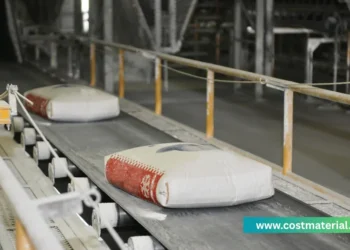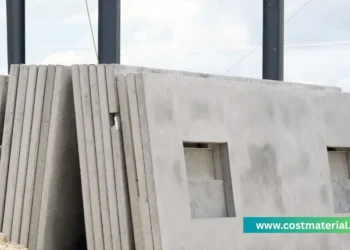Lumber is a fundamental material in Philippine construction, used for framing, flooring, roofing, and furniture. However, prices fluctuate due to supply, demand, and environmental policies. Whether you’re a contractor, builder, or DIY enthusiast, knowing the latest 2024 lumber price list helps in budgeting and procurement. But before we know about the unit price, lets learn first what lumber, its different type, uses, and importance.
Lumber, also known as timber, is a vital construction material made from processed wood, cut into standardized sizes for building and manufacturing. It comes from logs that are sawn, planed, and sometimes treated to enhance durability. In the Philippines, lumber is widely used in residential, commercial, and industrial projects due to its strength, versatility, and natural aesthetic appeal.
Types of Lumber
Lumber can be classified into two main categories:
1. Hardwood
Derived from deciduous trees (broad-leaved), hardwood is dense, durable, and resistant to wear. Common types in the Philippines include:
Narra – A premium, termite-resistant wood used for high-end furniture and flooring.
Yakal – Extremely strong, often used for heavy construction like bridges and wharves.
Mahogany – Moderately priced, commonly used for doors, cabinets, and decorative trim.
Tanguile & Apitong – Used for structural framing, beams, and outdoor applications.
2. Softwood
Sourced from coniferous trees (needle-leaved), softwood is lighter and easier to work with. Popular types include:
Gmelina – A fast-growing, affordable wood used for furniture and light construction.
Pine – Often used for interior paneling, crates, and temporary structures.
Rubberwood – Eco-friendly option for indoor furniture and flooring.
Common Uses of Lumber
Lumber plays a crucial role in various construction and manufacturing applications, such as:
Structural Framing – Beams, joists, and trusses in houses and buildings.
Flooring & Decking – Hardwood like narra and mahogany for elegant finishes.
Furniture Making – Tables, chairs, cabinets, and beds.
Doors & Windows – Tanguile and yakal for durability.
Scaffolding & Formwork – Temporary structures in construction.
Interior Design – Wall paneling, moldings, and decorative accents.
Why is Lumber Important?
Sustainability – When sourced responsibly, wood is a renewable material with a lower carbon footprint than steel or concrete.
Cost-Effectiveness – Locally available options like gmelina and lauan provide affordable alternatives for budget-conscious projects.
Versatility – Can be cut, shaped, and treated for various structural and aesthetic needs.
Natural Insulation – Wood provides better thermal and acoustic insulation compared to synthetic materials.
Aesthetic Value – Enhances interiors with natural grain patterns and warm tones.
Challenges in the Lumber Industry
Deforestation Concerns – Strict regulations limit logging of native trees like narra and yakal.
Price Volatility – Affected by supply chain issues, weather conditions, and import policies.
Maintenance Requirements – Untreated wood is prone to pests, rot, and warping if not properly maintained.
Lumber remains a cornerstone of Philippine construction due to its adaptability, affordability, and eco-friendly potential. Whether you’re building a house, crafting furniture, or working on a commercial project, choosing the right type of lumber ensures durability and cost efficiency. For the latest 2024 lumber prices, check our updated price guide sourced from trusted suppliers and government reports.
Factors Affecting Lumber Prices
Before diving into the price list, here’s why lumber costs vary:
✅ Wood Type – Premium woods (e.g., narra, yakal) cost more than common varieties (gmelina, lauan).
✅ Size & Thickness – Larger and thicker cuts are pricier.
✅ Supply & Demand – Logging bans and import policies impact availability.
✅ Location – Prices differ between Metro Manila, provinces, and remote areas.
✅ Seasonal Trends – Costs may rise during typhoon season due to increased demand for repairs.
Lumber Price List 2024 in the Philippines
(Prices are in PHP and may vary per supplier.)
| Lumber Type | Size (Thickness x Width x Length) | Unit | Price Range (PHP) |
|---|---|---|---|
| Lauan | 2" x 2" x 10' | pc | 90 – 130 |
| Mahogany | 2" x 3" x 10' | pc | 160 – 220 |
| Yakal | 2" x 4" x 12' | pc | 320 – 450 |
| Pine Wood | 1" x 6" x 12' | pc | 230 – 310 |
| Narra | 2" x 6" x 10' | pc | 550 – 800 |
| Gmelina | 1" x 2" x 10' | pc | 70 – 110 |
| Tanguile | 4" x 4" x 10' | pc | 380 – 520 |
| Red Lauan | 1" x 3" x 12' | pc | 140 – 190 |
| Apitong | 2" x 8" x 12' | pc | 480 – 680 |
| Mahogany | 1" x 4" x 8' | pc | 180 – 250 |
| Yakal | 2" x 12" x 10' | pc | 750 – 1,100 |
| Gmelina | 1" x 1" x 10' | pc | 45 – 75 |
| Tanguile | 3" x 3" x 12' | pc | 420 – 580 |
| Pine Wood | 1" x 8" x 10' | pc | 280 – 380 |
| Narra | 2" x 10" x 12' | pc | 900 – 1,400 |
Need an Excel copy of this table? Download here
Where to Buy Affordable Lumber in the Philippines?
To get the best deals, consider these trusted suppliers:
🏠 Wilcon Depot – Nationwide branches, competitive pricing.
🏠 CitiHardware – Regular promotions and bulk discounts.
🏠 Local Lumber Yards – Often cheaper for wholesale orders.
🏠 Online Marketplaces (e.g., Lazada, Shopee) – Some sellers offer delivery.
Pro Tip: Negotiate prices when buying in bulk (e.g., 100+ pieces).
FAQs on Lumber Prices
1. Which is the cheapest wood for construction?
✅ Gmelina (PHP 45–110 per pc) is the most budget-friendly.
2. Why is narra so expensive?
✅ Due to scarcity (protected species) and high demand for furniture.
3. Are lumber prices expected to increase in 2025?
✅ Likely, due to inflation and stricter logging regulations.
Final Thoughts
This lumber price list helps contractors, carpenters, and homeowners estimate costs accurately. For real-time pricing, always check with Wilcon, CitiHardware, or local suppliers before purchasing.
Did you find this guide helpful? Share it with fellow builders and homeowners! For more construction material price list, check our other blog post.














